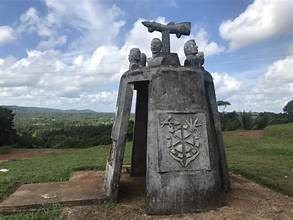The Mabaruma Stone Monument is a historical and cultural landmark located in Mabaruma, which is the capital of the Barima-Waini Region (Region 1) of Guyana. The monument has both historical and symbolic significance, particularly related to the history of the Indigenous people and the settlement of the region.
Location:
Mabaruma is situated in the northernmost part of Guyana, near the border with Venezuela, and is known for its relatively remote and tranquil environment. The Mabaruma Stone Monument is located within this region, highlighting the cultural importance of the area to local communities and visitors.
Significance and History:
The Mabaruma Stone Monument commemorates the rich history of Indigenous peoples in the region and is linked to the traditional settlements and legends of the Carib and Arawak tribes, which are the primary Indigenous groups in Guyana. It serves as a symbol of the resilience and strength of the Indigenous communities, and it holds importance as a cultural heritage marker in the country.
The monument is believed to be associated with the early colonial history of the area, which was influenced by the interactions between Indigenous peoples and European settlers, particularly the Dutch and British during the colonial period.
The Stone:
The stone itself is a large, weathered rock that stands as a prominent feature in the Mabaruma area. It is notable for its distinctive shape, which has been interpreted by some as a symbolic representation of the spiritual and cultural significance that the region holds for the Indigenous peoples. Some also associate the stone with ritualistic practices, though specific details about its exact use in ceremonies or rituals are not widely documented.
The monument’s appearance and the surrounding area may evoke feelings of reverence for those who recognize the deep-rooted connection that Indigenous groups have with the land, as well as the broader history of the region.
Cultural Impact:
The Mabaruma Stone Monument is not just an artifact of the past; it continues to serve as a cultural symbol for the people of Mabaruma and surrounding regions. The monument represents the importance of preserving the heritage and traditions of Indigenous communities, especially as they continue to face challenges related to cultural preservation, land rights, and modernization.
In the context of Guyana’s multicultural identity, the monument is a reminder of the diverse histories and legacies that contribute to the nation’s culture. It plays a role in educating both locals and visitors about the historical significance of the region’s Indigenous inhabitants.
Tourism and Accessibility:
The Mabaruma Stone Monument is not as widely known internationally as some of Guyana’s other major tourist attractions, but it holds a special place in the hearts of locals and those interested in exploring the more remote and authentic parts of the country. Visitors to Mabaruma can learn about the monument and its historical significance through local guides and community members who provide insights into the region’s Indigenous heritage.
Mabaruma is located quite a distance from Georgetown, and reaching it typically requires travel by road or air. The journey offers an opportunity to experience the natural beauty of Guyana’s rainforests and rivers, which makes the monument even more of a unique and remote destination for those willing to venture to this part of the country.
Conclusion: The Mabaruma Stone Monument serves as a symbol of Indigenous heritage and the long history of the region’s Indigenous peoples. It is an important landmark for those interested in Guyana’s cultural and historical roots, particularly in the context of Indigenous history and the region’s

